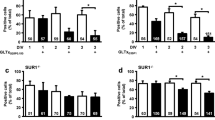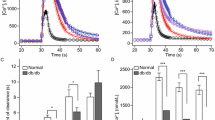Abstract
While high levels of glucose and saturated fatty acids are known to have detrimental effects on beta cell function and survival, the signalling pathways mediating these effects are not entirely known. In a previous study, we found that ADP regulates beta cell insulin secretion and beta cell apoptosis. Using MIN6c4 cells as a model system, we investigated if autocrine/paracrine mechanisms of ADP and purinergic receptors are involved in this process. High glucose (16.7 mmol/l) and palmitate (100 μmol/l) rapidly and potently elevated the extracellular ATP levels, while mannitol was without effect. Both tolbutamide and diazoxide were without effect, while the calcium channel blocker nifedipine, the volume-regulated anion channels (VRAC) inhibitor NPPB, and the pannexin inhibitor carbenoxolone could inhibit both effects. Similarly, silencing the MDR1 gene also blocked nutrient-generated ATP release. These results indicate that calcium channels and VRAC might be involved in the ATP release mechanism. Furthermore, high glucose and palmitate inhibited cAMP production, reduced cell proliferation in MIN6c4 and increased activated Caspase-3 cells in mouse islets and in MIN6c4 cells. The P2Y13-specific antagonist MRS2211 antagonized all these effects. Further studies showed that blocking the P2Y13 receptor resulted in enhanced CREB, Bad and IRS-1 phosphorylation, which are known to be involved in beta cell survival and insulin secretion. These findings provide further support for the concept that P2Y13 plays an important role in beta cell apoptosis and suggest that autocrine/paracrine mechanisms, related to ADP and P2Y13 receptors, contribute to glucolipotoxicity.










Similar content being viewed by others
References
Talchai C, Lin HV, Kitamura T, Accili D (2009) Genetic and biochemical pathways of beta-cell failure in type 2 diabetes. Diabetes Obes Metab 11(Suppl 4):38–45
Newsholme P, Gaudel C, McClenaghan NH (2010) Nutrient regulation of insulin secretion and beta-cell functional integrity. Adv Exp Med Biol 654:91–114
Corriden R, Insel PA (2010) Basal release of ATP: an autocrine-paracrine mechanism for cell regulation. Sci Signal 3:re1
Fitz JG (2007) Regulation of cellular ATP release. Trans Am Clin Climatol Assoc 118:199–208
Amisten S, Meidute-Abaraviciene S, Tan C, Olde B, Lundquist I, Salehi A, Erlinge D (2010) ADP mediates inhibition of insulin secretion by activation of P2Y13 receptors in mice. Diabetologia 53:1927–1934
Tan C, Salehi A, Svensson S, Olde B, Erlinge D (2010) ADP receptor P2Y(13) induce apoptosis in pancreatic beta-cells. Cell Mol Life Sci 67:445–453
Winzell MS, Ahren B (2007) Role of VIP and PACAP in islet function. Peptides 28:1805–1813
Taylor AL, Kudlow BA, Marrs KL, Gruenert DC, Guggino WB, Schwiebert EM (1998) Bioluminescence detection of ATP release mechanisms in epithelia. Am J Physiol 275:C1391–C1406
Menez C, Mselli-Lakhal L, Foucaud-Vignault M, Balaguer P, Alvinerie M, Lespine A (2012) Ivermectin induces P-glycoprotein expression and function through mRNA stabilization in murine hepatocyte cell line. Biochem Pharmacol 83:269–278
Warnotte C, Gilon P, Nenquin M, Henquin JC (1994) Mechanisms of the stimulation of insulin release by saturated fatty acids. A study of palmitate effects in mouse beta-cells. Diabetes 43:703–711
Salehi A, Flodgren E, Nilsson NE, Jimenez-Feltstrom J, Miyazaki J, Owman C, Olde B (2005) Free fatty acid receptor 1 (FFA(1)R/GPR40) and its involvement in fatty-acid-stimulated insulin secretion. Cell Tissue Res 322:207–215
Valverde MA, Bond TD, Hardy SP, Taylor JC, Higgins CF, Altamirano J, Alvarez-Leefmans FJ (1996) The multidrug resistance P-glycoprotein modulates cell regulatory volume decrease. EMBO J 15:4460–4468
El-Assaad W, Buteau J, Peyot ML, Nolan C, Roduit R, Hardy S, Joly E, Dbaibo G, Rosenberg L, Prentki M (2003) Saturated fatty acids synergize with elevated glucose to cause pancreatic beta-cell death. Endocrinology 144:4154–4163
Petit P, Lajoix AD, Gross R (2009) P2 purinergic signalling in the pancreatic beta-cell: control of insulin secretion and pharmacology. Eur J Pharm Sci 37:67–75
Scemes E, Bavamian S, Charollais A, Spray DC, Meda P (2008) Lack of “hemichannel” activity in insulin-producing cells. Cell Commun Adhes 15:143–154
Benfenati V, Caprini M, Nicchia GP, Rossi A, Dovizio M, Cervetto C, Nobile M, Ferroni S (2009) Carbenoxolone inhibits volume-regulated anion conductance in cultured rat cortical astroglia. Channels (Austin) 3:323–336
Jakab M, Grundbichler M, Benicky J, Ravasio A, Chwatal S, Schmidt S, Strbak V, Furst J, Paulmichl M, Ritter M (2006) Glucose induces anion conductance and cytosol-to-membrane transposition of ICln in INS-1E rat insulinoma cells. Cell Physiol Biochem 18:21–34
Best L (1997) Glucose and alpha-ketoisocaproate induce transient inward currents in rat pancreatic beta cells. Diabetologia 40:1–6
Best L, Brown PD, Sener A, Malaisse WJ (2010) Electrical activity in pancreatic islet cells: the VRAC hypothesis. Islets 2:59–64
Roman RM, Lomri N, Braunstein G, Feranchak AP, Simeoni LA, Davison AK, Mechetner E, Schwiebert EM, Fitz JG (2001) Evidence for multidrug resistance-1 P-glycoprotein-dependent regulation of cellular ATP permeability. J Membr Biol 183:165–173
Bani D, Brandi ML, Axiotis CA, Bani-Sacchi T (1992) Detection of P-glycoprotein on endothelial and endocrine cells of the human pancreatic islets by C 494 monoclonal antibody. Histochemistry 98:207–209
Li CJ, Zhou HL, Li J, Yao HT, Su R, Li WP (2011) Roles of sulfonylurea receptor 1 and multidrug resistance protein 1 in modulating insulin secretion in human insulinoma. Hepatobiliary Pancreat Dis Int 10:88–94
Barg S, Renstrom E, Berggren PO, Bertorello A, Bokvist K, Braun M, Eliasson L, Holmes WE, Kohler M, Rorsman P, Thevenod F (1999) The stimulatory action of tolbutamide on Ca2+-dependent exocytosis in pancreatic beta cells is mediated by a 65-kDa mdr-like P-glycoprotein. Proc Natl Acad Sci U S A 96:5539–5544
Tang YZ, Li DQ, Sun FJ, Li L, Yu DM (2009) P-glycoprotein regulating biphasic insulin secretion in rat pancreatic beta cells. Chin Med J (Engl) 122:2587–2592
Tian G, Sandler S, Gylfe E, Tengholm A (2011) Glucose- and hormone-induced cAMP oscillations in alpha- and beta-cells within intact pancreatic islets. Diabetes 60:1535–1543
Landa LR Jr, Harbeck M, Kaihara K, Chepurny O, Kitiphongspattana K, Graf O, Nikolaev VO, Lohse MJ, Holz GG, Roe MW (2005) Interplay of Ca2+ and cAMP signaling in the insulin-secreting MIN6 beta-cell line. J Biol Chem 280:31294–31302
Jhala US, Canettieri G, Screaton RA, Kulkarni RN, Krajewski S, Reed J, Walker J, Lin X, White M, Montminy M (2003) cAMP promotes pancreatic beta-cell survival via CREB-mediated induction of IRS2. Genes Dev 17:1575–1580
Yang E, Zha J, Jockel J, Boise LH, Thompson CB, Korsmeyer SJ (1995) Bad, a heterodimeric partner for Bcl-XL and Bcl-2, displaces Bax and promotes cell death. Cell 80:285–291
Acknowledgments
This study was supported by the Swedish Heart and Lung Foundation, Swedish Scientific Research Council, Diabetes Wellness Network, Sweden, The Vascular Wall Program and Lund University.
Conflicts of interest
The authors declare that there are no conflicts of interest.
Author information
Authors and Affiliations
Corresponding author
Rights and permissions
About this article
Cite this article
Tan, C., Voss, U., Svensson, S. et al. High glucose and free fatty acids induce beta cell apoptosis via autocrine effects of ADP acting on the P2Y13 receptor. Purinergic Signalling 9, 67–79 (2013). https://doi.org/10.1007/s11302-012-9331-6
Received:
Accepted:
Published:
Issue Date:
DOI: https://doi.org/10.1007/s11302-012-9331-6




